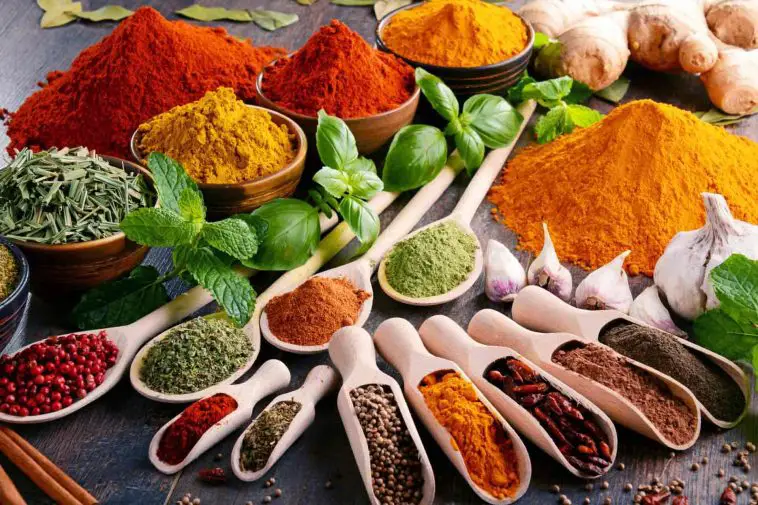Herbs and spices are the cornerstone of flavor in culinary arts. Their use dates back to ancient civilizations, where they were prized for their ability to transform simple ingredients into aromatic and flavorful dishes. Herbs, typically derived from the leafy green parts of plants, and spices, often obtained from seeds, fruits, roots, and barks, have been integral in culinary traditions across the world. Their importance extends beyond mere taste enhancement; they also contribute to food preservation and have been historically valued for their medicinal properties.
Types of Herbs and Spices
Herbs and spices are broadly classified based on their plant origin and part used. Herbs like basil, parsley, and thyme are often fresh or dried leafy greens, while spices such as cinnamon, nutmeg, and pepper are derived from other plant parts. Commonly used herbs in cooking include oregano, sage, and rosemary, known for their aromatic properties. Spices like turmeric, cumin, and coriander are staples in many kitchens, celebrated for their intense flavors and colors. Each herb and spice carries its unique profile, influencing the texture, aroma, and taste of food, making them indispensable in creating diverse and rich culinary experiences.
For a deeper dive into the world of spices, consider exploring resources like Appliance City’s Guide, which offers practical tips on using herbs and spices.
Herbs and Spices for Different Types of Meat
- Beef: Robust and hearty, beef pairs well with bold herbs and spices. Rosemary, thyme, and bay leaves enhance its rich flavor, while garlic and black pepper add depth. A popular combination is a mix of rosemary, thyme, and garlic, rubbed onto the meat before cooking.
- Pork: Pork’s versatility allows for a range of seasonings. Sage and thyme bring out its natural sweetness, while fennel seeds and mustard add a piquant edge. A blend of sage, garlic, and black pepper is ideal for pork roasts and chops.
- Lamb: Lamb’s distinct flavor is complemented by rosemary, mint, and oregano. Garlic and cumin also pair well, offering a balance of earthiness and warmth. A classic combination is rosemary, garlic, and mint, perfect for grilled or roasted lamb.
- Chicken: Commonly used herbs and spices like garlic, tarragon, and coriander work well with chicken. For more ideas on seasoning chicken, Living On A Dime’s Herb Guide provides easy pairing suggestions.
Herbs and Spices for Fish and Seafood
Fish and seafood are often best complemented by light and fresh herbs and spices. Dill, parsley, and lemon zest enhance the delicate flavors of fish like salmon and trout. Tarragon and chives work well with white fish, offering a subtle anise-like sweetness. For shellfish, like shrimp and lobster, garlic, paprika, and cayenne pepper add a flavorful kick. A simple yet effective combination for fish is dill, lemon zest, and black pepper, which can be sprinkled over before cooking. For enhancing the natural sweetness of seafood, a mix of garlic, paprika, and a hint of cayenne is recommended.
Herbs and Spices for Vegetarian Dishes
Vegetarian dishes benefit greatly from the use of herbs and spices, which add depth and complexity to plant-based ingredients. Basil, oregano, and thyme are excellent for seasoning a variety of vegetables, from leafy greens to root vegetables. Cumin, coriander, and turmeric lend a warm, earthy flavor to legumes and tofu, making them more palatable and interesting. For roasting vegetables, a combination of rosemary, thyme, and garlic works wonderfully, creating a savory and aromatic dish. In tofu dishes, a blend of turmeric, cumin, and a dash of cayenne pepper can mimic the complexity of flavors often found in meat-based dishes, making them equally satisfying.
Herbs and Spices in World Cuisines
Herbs and spices are not just culinary ingredients; they are cultural signatures. Each cuisine around the world has its unique herb and spice palette that defines its flavor profile. For instance, Italian cuisine is renowned for its use of basil, oregano, and rosemary, essential in dishes like pasta and pizza. Indian cuisine, on the other hand, is characterized by a rich array of spices like turmeric, cumin, and coriander, giving its dishes a distinctive warmth and depth. In Mexican cooking, cilantro, cumin, and chili peppers are staples, adding vibrancy and heat. These examples illustrate how herbs and spices are more than just taste enhancers; they are an expression of cultural identity and culinary tradition.
Creating Flavorful Combinations
Creating unique flavor combinations with herbs and spices is an art form. The key is to understand the flavor profile of each ingredient. For instance, rosemary and thyme offer a woodsy note, pairing well with meats, while cilantro and lime add a fresh zing to seafood. Experimenting with different combinations can lead to delightful discoveries. Start with small amounts to understand how flavors meld and adjust according to taste. A good rule of thumb is to pair strong flavors with milder ones to create balance. For example, the sharpness of garlic can be mellowed with the sweetness of basil. Remember, cooking is a creative process, and experimenting with herbs and spices is a big part of the fun.
Storing and Handling Herbs and Spices
Proper storage and handling of herbs and spices are crucial for maintaining their flavor and potency. Dried herbs and spices should be stored in airtight containers in a cool, dark place to prevent loss of aroma and color. Avoid storing them above the stove or in direct sunlight, as heat and light can cause them to deteriorate quickly. Fresh herbs can be wrapped in damp paper towels and stored in the refrigerator, or even frozen for longer shelf life. It’s also important to regularly check and replace your herbs and spices, as they lose their potency over time. Ground spices typically last about six months, while whole spices can stay fresh for up to a year. Fresh herbs, when properly stored, can last for a couple of weeks.
FAQs
- What are the best herbs to use with chicken?
- Thyme, rosemary, and sage are excellent with chicken, offering a balance of earthy and aromatic flavors.
- Can I mix fresh and dried herbs in a dish?
- Yes, you can mix fresh and dried herbs. Dried herbs are more concentrated, so use them in smaller quantities compared to fresh herbs.
- How do I substitute dried herbs for fresh ones?
- A general guideline is to use one-third the amount of dried herbs to fresh herbs. For example, if a recipe calls for 1 tablespoon of fresh oregano, use 1 teaspoon of dried oregano.
- Do spices expire?
- Spices don’t necessarily expire, but they lose potency over time. It’s best to replace them every six months to a year for optimal flavor.
- How can I grind whole spices?
- Whole spices can be ground using a spice grinder, a mortar and pestle, or even a clean coffee grinder for a fresher, more robust flavor.
Conclusion and Encouragement to Experiment
In conclusion, herbs and spices are more than just seasoning; they are the soul of cooking, offering endless possibilities to enhance and transform dishes. Understanding their unique flavors and learning how to combine them can elevate your culinary skills. Remember, the best way to learn is through experimentation. Don’t be afraid to try new combinations and adjust to your taste. Cooking is a personal journey, and herbs and spices are your companions, guiding you towards more flavorful and exciting culinary adventures. So go ahead, experiment, and enjoy the rich world of flavors that herbs and spices bring to your kitchen.






Comments
Loading…